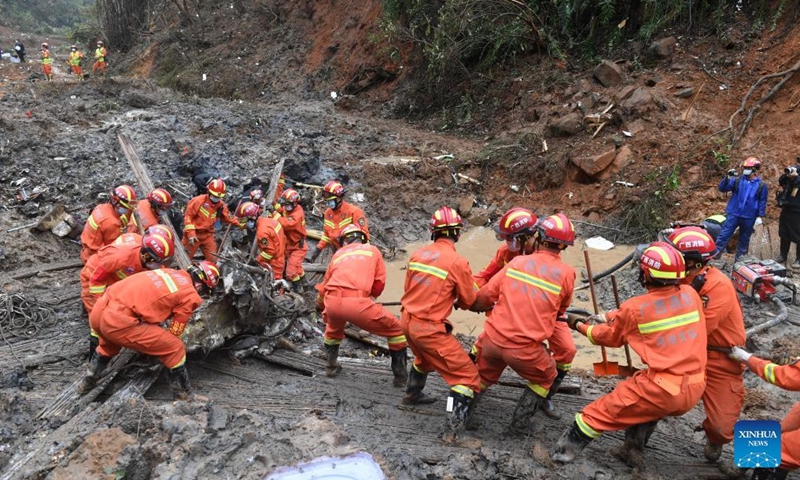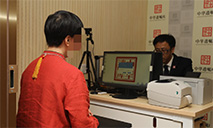Lost control of plane could have led to crash: experts

Rescuers conduct search and rescue work at a plane crash site in Tengxian County, south China's Guangxi Zhuang Autonomous Region, March 24, 2022.Photo:Xinhua
A sudden nosedive of the China Eastern Airlines jet has triggered wide discussions on the accident's cause, and Chinese aviation experts said the pilot losing control of the airplane could be one of the reasons behind the disaster.
One of the reasons for the sudden fall could be a sudden failure of the flight control system, resulting in a nosedive, Huang Jun, a professor of School of Aeronautic Science and Engineering with Beihang University, told the Global Times on Friday.
Huang also said the aircraft's body would be damaged immediately, resulting in a loss of lift or control, that such move is commonly referred to as air disintegration. But air disintegration does not mean breaking into pieces.
There may be other mechanical failures in the aircraft, he added.
Wang Ya'nan, chief editor of Beijing-based Aerospace Knowledge, earlier shared a similar prediction.
Judging from the flight data, there is no reason to indicate that the pilot made any contact with ground control. It is likely that the aircraft lost power at a cruising altitude, resulting in the pilot losing control of the aircraft, Wang told the Global Times.
It could be a very serious technical failure, in which the plane inevitably enters a high-speed descent, Wang noted.
The Civil Aviation Administration of China (CAAC) said on Tuesday that the plane took off from Kunming, Southwest China's Yunnan Province at 1:16 pm on Monday, and entered the Guangzhou air traffic control area at a cruising altitude of 8,900 meters at 2:17 pm.
At 2:20 pm, the controller noticed that the aircraft's altitude had dropped sharply, and immediately called the crew several times, but did not receive a reply. At 2:23 pm, the radar signal disappeared.
Bloomberg reported that the plane was knifing through the air at more than 640 miles (966 kilometers) per hour, and at times may have exceeded 700 mph, and the preliminary data indicates it was near the speed of sound.
On-site search and rescue found that most of the wreckage of the aircraft was concentrated in an area of about 30 meters in radius around the main impact point, and the depth extended to about 20 meters.
Communication was normal until the plane went missing, and the crew members did not send any distress signal, Liu Xiaodong, spokesperson of China Eastern Airlines, said at the press conference on Friday in Wuzhou, South China's Guangxi Zhuang Autonomous Region.
The specific cause of the accident can only be determined when the black boxes are recovered and analyzed, and the first black box, the cockpit voice recorder has been sent to a laboratory in Beijing for analysis.
Mao Yanfeng, director of the CAAC's accident investigation unit, said on Friday that there is still "no definite time" when the process will be completed.
The search team is searching for the second one.
The two black boxes are key to determining the cause of the accident, Huang said.
As for the accident investigation, Gao Yuanyang, dean of the general aviation industry research center at Beihang University, told the Global Times on Friday that it is a very rigorous process, for it includes the collection and screening of data, the deduction of the accident, and the confirmation of the cause of the accident.
The process is often very complex, especially if we do not have enough data or information, which will take a long time, Gao added.
The US National Transportation Safety Board (NTSB) told the Global Times on Thursday that it is working with the US and Chinese governments to solve visa and COVID quarantine issues before participating in crash investigation efforts in China.
The NTSB was notified of the accident on Monday by CAAC, and the accredited representative and technical advisors have been appointed, and they are in contact with the CAAC investigator-in-charge, NTSB said.
Accredited representatives are entitled to appoint technical advisors to assist them in the investigation, NTSB noted.
Photos
 Increasingly more young adults in China register wills that include virtual assets
Increasingly more young adults in China register wills that include virtual assets Rapeseed flowers turn NW China's Luoping into picturesque spring wonderland
Rapeseed flowers turn NW China's Luoping into picturesque spring wonderland Why do people in China fall for animated characters like LinaBell and Bing Dwen Dwen?
Why do people in China fall for animated characters like LinaBell and Bing Dwen Dwen? Photo Album: architecture in Beijing merging history and modernity
Photo Album: architecture in Beijing merging history and modernity
Related Stories
Copyright © 2022 People's Daily Online. All Rights Reserved.






